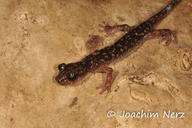|
Description
Total length of males to 133 mm for males (average 122 mm), up to 150 mm for
females (average 111 mm. Adult males have a mental gland on the chin.
Limbs well developed, hind legs slightly longer than front legs. Front feet
with 4, hind feet with 5 broad, flattened digits that are widened distally.
Base color from dark brown to black, with marbled pattern. Pattern may be in
yellow, ochre or green. The base color is either bright ("imperialis"-type)
or dark ("funereus"-type). The dark V, inverted V or X pattern in
the neck, as also described for H. flavus, can also be present in
this species. The ventral side is bright and sometimes translucent, showing
the abdominal organs and their contents. The brown or black spotting of the
throat, venter and tail is stronger in this species than in H. flavus.
There are no cases of albinism known for this species (Boehme et al 1999).
Distribution and Habitat
Country distribution from AmphibiaWeb's database: Italy
H. imperialis is an endemic of Central, Central-eastern and Southeastern
Sardinia, occurring roughly between 40º N and 39º30' N, westwards as far as
08º55' E, in the provences of Nuoro, Oristano and Cagliari (Gasc 1997).
The preferred temperature of H. imperialis and other Sardinian
Hydromantes species is slightly higher than that of mainland species.
H. imperialis is very abundant, like other Hydromantes species,
in caves and under rocks (Boehme et al 1999).
Life History, Abundance, Activity, and Special Behaviors
Ecology and habitat of H. imperialis is similar to that of
H. ambrosii. H. imperialis has been bred in captivity.
Observations on the reproductive biology of this species were made in a
terrarium that was kept at 8-12º C in wintertime and up to 15º C in summertime.
Unfortunately, there were no observations on the mating or the spermatophores.
On January 17th,, 1996, a clutch of freshly laid eggs were found with
diameters of 5-6mm. The female kept close to the eggs and only left her eggs
for short foraging escapades at night. Two eggs were eaten. The first three
eggs hatched after 173 days (on July 5th), followed by the fourth, a good two
days later. The hatchlings had an average total length of 26.7mm The juveniles remained in the vicinity of the female for 14 days, living on the remaining yolk, before they spread out and started to feed.
This species can be very abundant locally, depending on the season. The
concentration of H. imperialis reaches the highest concentrations of
any European Plethodontid in some caves. In one instance the Grotta degli
Spelerpes contained at least 500 individuals in the first 10-12 meters
(Boehme et al 1999).
This species is unique in producing a strong smell when handled, hence the
Italian common name "Geotritone oderoso".
Trends and Threats
This species is not endangered. It is abundant in a relatively large and
mostly inaccessible area (Boehme et al 1999).
References
Boehme, W., Grossenbacher, K., and Thiesmeier, B. (1999). Handbuch der Reptilien und Amphibien Europas, band 4/I:Schwanzlurche (Urodela). Aula-Verlag, Wiesbaden.
Gasc, J.-P. (1997). Atlas of Amphibians and Reptiles in Europe. Societas Europaea Herpetologica, Bonn, Germany.
Stumpel-Rieks, S. E. (1992). Nomina Herpetofaunae Europaeae. AULA-Verlag, Wiesbaden.
Originally submitted by: Arie van der Meijden (first posted 1999-11-30)
Edited by: David B. Wake (2021-01-26)Species Account Citation: AmphibiaWeb 2021 Hydromantes imperialis: Imperial Cave Salamander <https://amphibiaweb.org/species/4075> University of California, Berkeley, CA, USA. Accessed Apr 16, 2024.
Feedback or comments about this page.
Citation: AmphibiaWeb. 2024. <https://amphibiaweb.org> University of California, Berkeley, CA, USA. Accessed 16 Apr 2024.
AmphibiaWeb's policy on data use.
|




 Raffaëlli Account
Raffaëlli Account Map of Life
Map of Life